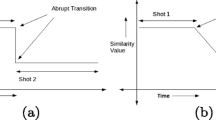Abstract
A shot presents a contiguous action recorded by an uninterrupted camera operation and frames within a shot keep spatio-temporal coherence. Segmenting a serial video stream file into meaningful shots is the first pass for the task of video analysis, content-based video understanding. In this paper, a novel scheme based on improved two-dimensional entropy is proposed to complete the partition of video shots. Firstly, shot transition candidates are detected using a two-pass algorithm: a coarse searching pass and a fine searching pass. Secondly, with the character of two-dimensional entropy of the image, correctly detected transition candidates are further classified into different transition types whereas those falsely detected shot breaks are distinguished and removed. Finally, the boundary of gradual transition can be precisely located by merging the characters of two-dimensional entropy of the image into the gradual transition. A large number of video sequences are used to test our system performance and promising results are obtained.
Similar content being viewed by others
References
Kikukawa T, Karafuto S. Development of an automatic summary editing system for the audio-visual resources. Trans Electr Inf, 1992, 2(2): 204–212
Bang C C, Chenl S C, Shyu M L. A system for video shot detection. In: Proc. ICS, 2003. 1320–1324
Otsuji K, Tonomura Y, Ohba Y. Video browsing using brightness data. In: Proc. VCIP, 1991. 980–989
Meng J H, Juan Y J, Chang S. Scene change detection in a MPEG compressed video sequence. In: Inter. Sym. Electronic Imaging, 1995. 14–25
Shahraray B. Scene change detection and content-based sampling of video sequence. In: SRIVD, 1995. 2–13
Xiong W, John C M. Efficient scene change detection and camera motion annotation for video classification. J Comput Vision Image Understand, 1998, 71(2): 166–181
Hanjalic A. Shot-boundary detection: Unraveled and resolved? IEEE Trans Circuits Syst Video Tech, 2002, 12(2): 90–105
Zhang H J, Kankanhalli A, Smoliar S W. Automatic partitioning of full-motion video. Trans ACM Multimedia, 1993, 1(1):10–28
Zabih R, Miller J, Mai, K. A feature-based algorithm for detecting and classifying production effects. Trans ACM Multimedia, 1999, 7(2): 119–128
Yu J, Srinath M D. An efficient method for scene cut detection. J Patt Recog Lett, 2001, 22(13): 1379–1391
Rasheed Z, Mubarak S. Scene detection in Hollywood movies and TV shows. In: CVPR, 2003. 343–348
Cernekova Z, Kotropoulos C, Pitas I. Video shot segmentation using singular value decomposition. In: Proc. ICME, 2003. 301–302
Zabih R, Miller J, Mai K. A feature-based algorithm for detecting and classification production effects. Trans ACM Multimedia, 1999, 7(1): 119–128
Geng Y L, Xu D. A solution to illumination variation problem in shot detection. In: ICME, 2004. 81–84
Nam J, Tewfik A H. Detection of gradual transitions in video sequences using B-spline interpolation. IEEE Trans Multimedia, 2005, 7(4): 667–679
Wolf W. Key frame selection by motion analysis. In: Proc. ICASSP, 1996. 1228–1231
Koprinska I, Carrato S. Detecting and classifying video shot boundaries in MPEG compressed sequences. In: Europe Conf. Signal Processing, 1998. 1729–1732
Zhuang Y T, Rui Y, Huang T S, et al. Adaptive key frame extraction using unsupervised clustering. In: ICIP, 1998. 866–870
Boreczky J S, Wilcox L D. A hidden Markov model framework for video segmentation using audio and image features. In: ICASSP, 1998. 3741–3744
Lienhart R. Reliable dissolve detection. In: SRMD, 2001. 219–230
Qi Y, Huuptmunn A G, Liu T. Supervised classification for video shot segmentation. In: ICME, 2003. 689–672
Yuan J H, Zhang B, Lin F Z. Graph partition model for robust temporal data segmentation. In: Pacific-Asia Conf. Knowledge Discovery and Data Mining, 2005. 758–763
Cerneková Z, Pitas I, Nikou C. Information theory-based shot cut fade detection and video summarization. IEEE Trans Circuits Syst Video Tech, 2006, 16(1): 82–91
Boccignone G, Chianese A, Moscato V, et al. Foveated shot detection for video segmentation. IEEE Trans Circuits Syst Video Tech, 2005, 15(3): 365–377
Prasanna P K, Sahoo K, Arora G. A thresholding method based on two-dimensional Renyi’s entropy. J Patt Recog, 2004, 37(6): 1149–1161
Sahoo P K, Arora G. Image thresholding using twodimensional Tsallis-Havrda-Charva entropy. J Patt Recog Lett, 2006, 27(6): 520–528
Li Y, Mao Z, Tian L, et al. A kind of two-dimensional entropic image segmentation method based on artificial immune algorithm. In: WCICA, 2006. 10412–10415
Renyi A. On measures of entropy and information. In: 4th Berkeley Symposium on Mathematically Statistical Probability, 1961. 547–561
Author information
Authors and Affiliations
Corresponding author
Additional information
Supported by the National Natural Science Foundation of China (Grant No. 60675017) and National Basic Research Program of China (Grant No. 2006CB303103)
Rights and permissions
About this article
Cite this article
Zhu, S., Liu, Y. Two-dimensional entropy model for video shot partitioning. Sci. China Ser. F-Inf. Sci. 52, 183–194 (2009). https://doi.org/10.1007/s11432-009-0057-1
Received:
Accepted:
Published:
Issue Date:
DOI: https://doi.org/10.1007/s11432-009-0057-1




